
Squirrels are members of the family Sciuridae, a family that includes small or medium-size rodents. The squirrel family includes tree squirrels, ground squirrels, and flying squirrels. Squirrels are indigenous to the Americas, Eurasia, and Africa, and were introduced by humans to Australia. The earliest known fossilized squirrels date from the Eocene epoch, and among other living rodent families, the squirrels are most closely related to the mountain beaver and to the dormice.
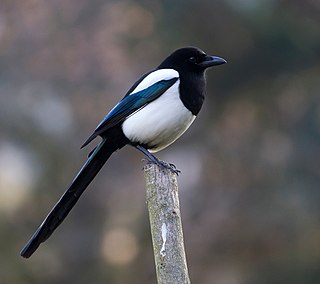
Magpies are birds of the Corvidae family. Like other members of their family, they are widely considered to be intelligent creatures. The Eurasian magpie, for instance, is thought to rank among the world's most intelligent creatures and is one of the few nonmammalian species able to recognize itself in a mirror test. They are particularly well known for their songs and were once popular as cagebirds. In addition to other members of the genus Pica, corvids considered as magpies are in the genera Cissa, Urocissa, and Cyanopica.

The water voles are large voles in the genus Arvicola. They are found in both aquatic and dry habitat through Europe and much of northern Asia. A water vole found in Western North America was historically considered a member of this genus, but has been shown to be more closely related to members of the genus Microtus. Head and body lengths are 12–22 cm, tail lengths are 6.5–12.5 cm, and their weights are 70–250 g. The animals may exhibit indeterminate growth. They are thick-furred and have hairy fringes on their feet that improve their swimming ability.

Lycaena is a genus of butterflies. The genus range is Holarctic, with the exception of four species found in New Zealand, two in South Africa, one in New Guinea and one in Java. It is commonly divided into several subgenera, such as Antipodolycaena. Many formerly independent genera are now subsumed within Lycaena; the genus Gaiedes may also belong here. Many of the subgenera, species groups and species listed here may be synonyms.

Sericoda is a genus of harpaline ground beetles. They are native to the Holarctic. Their habit resembles some members of the related genus Agonum, but they are generally smaller. The origin of Sericoda is apparently North America, with the Central American genus Elliptoleus the closest living relative.

Acartophthalmus is a genus of flies, and the only genus with confident placement in the family Acartophthalmidae. They are 1.0–2.5 millimetres (0.04–0.10 in) long, and grey or black in colour, with pubescent arista. Only five species are included.
Diamesinae is a subfamily of midges in the non-biting midge family (Chironomidae).

Blethisa is a genus in the beetle family Carabidae. There are about nine described species in Blethisa, found in the Holarctic.

Badister is a genus of ground beetle in the family Carabidae native to North Africa, the Near East, and the Holarctic, including Europe.
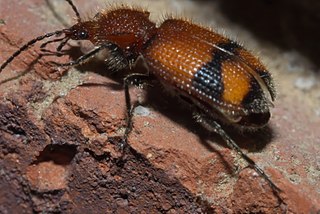
Panagaeus is a genus in the beetle family Carabidae, native to the Holarctic, the Near East, and North Africa, as well as Central and South America. There are about 15 described species in Panagaeus.

Patrobus is a genus of ground beetles in the family Carabidae. There are more than 20 described species in Patrobus.

Byturidae, also known as fruitworms, are small family of cleroid beetles with over 15 described species, primarily distributed in the Holarctic and Southeast Asia. The larvae of at least some genera feed on fruit, such as Byturus, a notable commercial pest of Rubus consuming both the fruit and seeds, while others like Xerasia are associated with catkins. The adults are known to feed on developing leaves, flowers and pollen.

Pygmy ground squirrels are small ground squirrels in the genus Xerospermophilus, family Sciuridae, containing four species from Mexico and the United States. The members of this genus were formerly placed in the large ground squirrel genus Spermophilus. Since DNA sequencing of the cytochrome b gene has shown Spermophilus to be paraphyletic to the prairie dogs and marmots, this group is now separated, along with six other genera. Within the genus, the Mohave ground squirrel and the round-tailed ground squirrel were thought to be close relatives, sometimes a subgenus Xerospermophilus, while the spotted ground squirrel and the Perote ground squirrel were placed in the subgenus Ictidomys.

Laphria is a genus described by Johann Wilhelm Meigen in 1803, belonging to the family Asilidae, subfamily Laphriinae. Members of this genus are known as bee-like robber flies. This genus has a Holarctic distribution, occurring in Europe, Asia, and North America. They prey on a variety of insects, including other robber flies, bees, wasps and beetles. Like other asilids, they use their proboscis to penetrate the body of their prey and inject enzymes which dissolve the tissues.
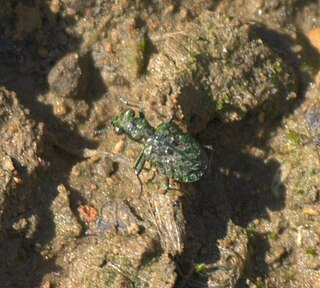
Elaphrinae is a subfamily of ground beetles in the family Carabidae. There are at least 4 genera and more than 50 described species in Elaphrinae.

Philorhizus is a genus in the beetle family Carabidae. There are more than 50 described species in Philorhizus.
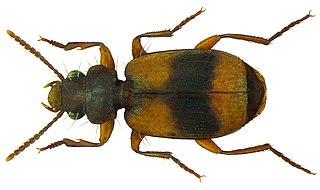
Somotrichus is a genus in the beetle family Carabidae. This genus has a single species, Somotrichus unifasciatus. It is found in the Holarctic.
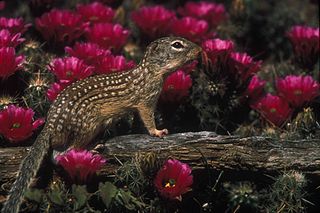
Ictidomys is a North American genus of rodent in the squirrel family, which contains the thirteen-lined ground squirrel, the Mexican ground squirrel, and the Rio Grande ground squirrel. These species were included in the species-rich ground squirrel genus Spermophilus until molecular data showed that this genus was not a natural, monophyletic grouping.

The Rio Grande ground squirrel is a species of squirrel in the family Sciuridae. It is found in the south-western United States and in north-eastern Mexico.
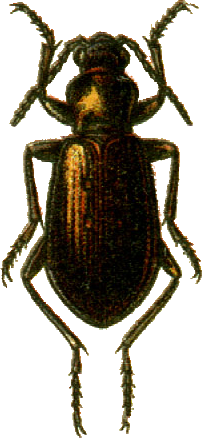
Diacheila arctica is a species of ground beetle in the family Carabidae. It is found in Europe and Northern Asia and North America.



















